Future Work
Gelatin
The ways gelatin contributes to paper stability merits additional research. It would be interesting to learn if the film-forming capabilities or other properties of gelatin allow it to help limit the penetration of pollutant or other gasses that can contribute to deleterious reactions in cellulose. Air pollution may turn out to be one of the main contributors to the loss of paper stability over time. The SEM (scanning electron microscope) images below give a visual sense of how gelatin size application impacts paper at the surface of individual fibers in Whatman Grade 4 Chr paper. Note the coated appearance of the fibers in figures 20 and 21 relative to figures 16 and 17.
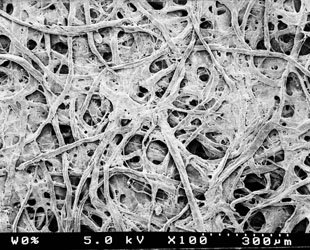
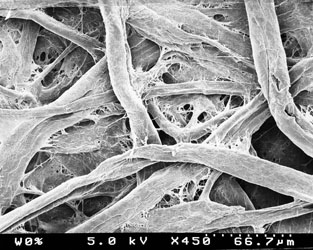
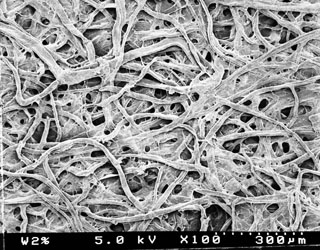
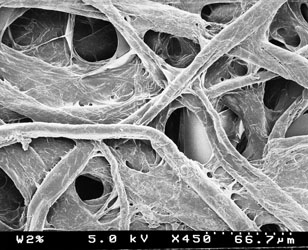
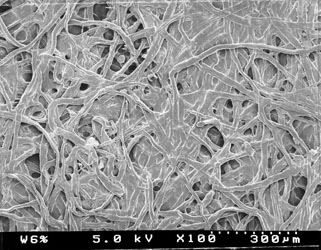
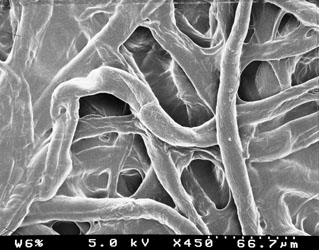
In figures 22 and 23 (below), historical papers in very poor and excellent condition can be compared under the same 100× magnification seen in the figures 16, 18, and 20 (above). Some of the same coating effect seen in figures 18 and 20 may be apparent in areas of figure 23.
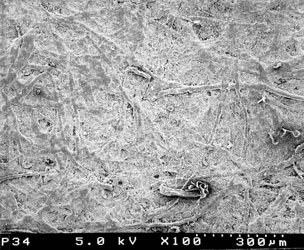
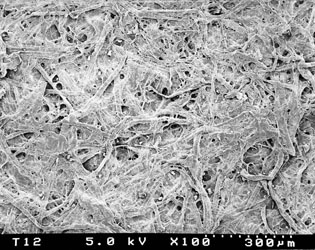
Relative humidity cycling is known to have a negative impact on paper stability. Therefore, knowing if gelatin has the ability to help moderate RH and moisture-content swings in paper is of interest. John Baty and Timothy Barrett found that gelatin-sized paper responds to large swings in RH in the same way unsized paper does when measured by changes in paper mass; however, the sized paper consistently picked up and held more weight (moisture) during those changes.1 This appears to indicate that gelatin has little or no effect in RH moderation. However, a different measurement technique capable of monitoring RH changes within individual fibers might show that gelatin film can indeed moderate changes in RH in cellulose.
Beyond the protective and mechanical-strengthening role of gelatin as a sizing or resizing material in paper, Gary Frost has advocated continued exploration of gelatin-sized materials and gelatin-augmented pastes in conservation treatment: “The attributes of gelatin sizing in mending materials is improved tack, conformation, adhesion, and wet strength during manipulations and sealing. This is all apparent as working properties reveal themselves in practice. Another opportunity is presented by gelatin-augmented paste, again with attributes of tack and bonding strength combined with open work time not characteristic of synthetic adhesives. Add to all this that the factors of reversibility are either maintained or advanced over straight pastes and greatly advanced over adhesives keyed with synthetics. Obstacles in practice to use of glues are fairly innocuous. Glues buffer papers for acid hydrolysis, but the protective role and demonstrated stability of tans, cures, sizings, and fibrous materials at lower pH counters the old pH qualifier. Inconvenience of adding extra steps and extra ingredients is not a big obstacle if the outcome is error-free work of assured performance. Supply is not an obstacle either, due to wide production of food-grade gelatin.”2
The actual loss of gelatin during aqueous treatment deserves additional research attention. Particularly when cooler solutions are used, loss may turn out to be minimal. Such a finding would obviate the need for resizing with gelatin or any other material. Also, aqueous treatments may impact the vegetable-based sizes used in traditionally made Islamic papers significantly more than they do gelatin-sized papers, indicating a need for quite different treatment protocols.
New paper-history and paper-stability studies
Additional field studies with portable nondestructive instrumentation can shed new light on papermaking history and paper stability. It would be of great interest to survey specimens from even earlier dates to confirm when gelatin first came into use in Europe and how it impacted paper quality and stability compared with the sizing materials used earlier by Islamic papermakers. Indeed it would be a great contribution to the study of papermaking history to know more about what materials and methods were used to produce the longest lasting Islamic papers, some of which have exceptional stability and aesthetic characteristics.
Future studies on long-term naturally aged papers should be based on sample sets of paper specimens found in significantly different condition but bound in the same book. Such sample sets avoid much of the concern about unknown storage conditions in studies of naturally aged papers.
Other
Additional work needs to be done to perfect portable instrumentation and make it more accurate and, ideally, less expensive. Much headway has been made in some of these areas, in particular NIR work by Matija Strlič et al.,3 and Linda Cséfalvayová et al.4 With increased sensitivity and lower priced instruments, routine and accurate documentation of various properties of artifacts could be done quickly and relatively easily before and after treatment. Such instrumentation could also serve in helping to date, place, authenticate, or do condition assessments of works on paper. Despite our lack of success with ultrasonic (US) testing during the present research (see Experiment B), US remains an interesting technique. Advances might still be made if laboratory-prepared aged-paper specimens can be analyzed to better understand the changes that take place during long-term natural aging and how those changes impact US analysis results.
[1] J. Baty and T. Barrett, “Gelatin Size as a pH and Moisture Content Buffer in Paper,” Journal of the American Institute for Conservation 46, no. 2 (2007): 105–21.
[2] Personal communication from Gary Frost to T. Barrett (e-mail, August 10, 2011). See also “Gelatin Sized Kozo Fiber Papers for Book Conservation—Experiments by Caitlin Moore and Gary Frost” (unpublished MS, September 29, 2010).
[3] M. Strlič, D. Lichtblau, J. Kolar, T. Trafela, L. Cséfalvayová, M. Anders, B. de Bruin, et al., “SurveNIR Project—A Dedicated Instrument for Collection Surveys,” in Durability of Paper and Writing 2, presented September 10, 2008 (Ljubljana, Slovenia: National University Library, 2004).
[4] L. Cséfalvayová, M. Pelikan, I. Kralj Cigić, J. Kolar, and M. Strlič, “Use of Genetic Algorithms with Multivariate Regression for Determination of Gelatine in Historic Papers Based on FT-IR and NIR Spectral Data,” Talanta 82 (2010): 1784–90. doi:10.1016/j.talanta.2010.07.062


